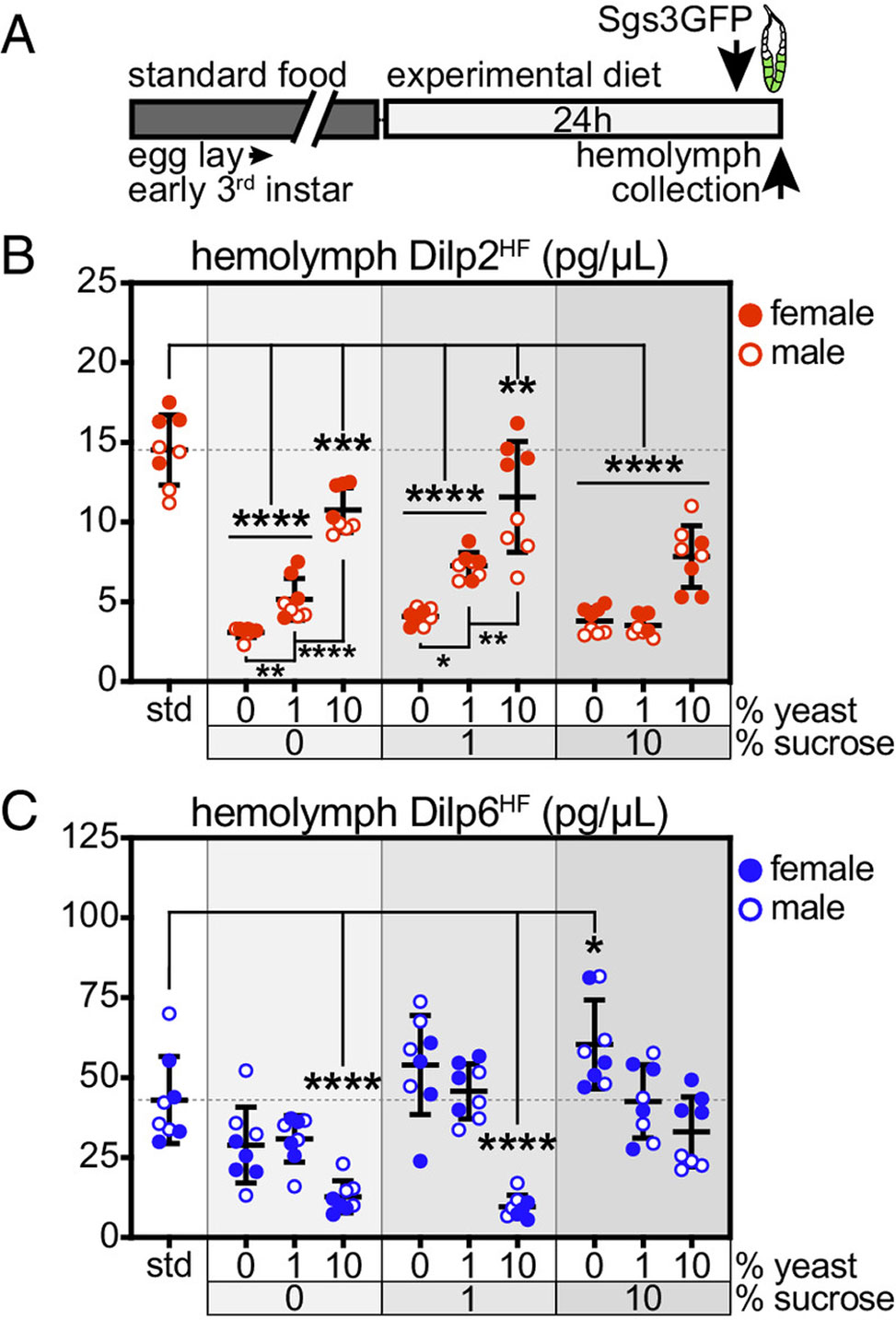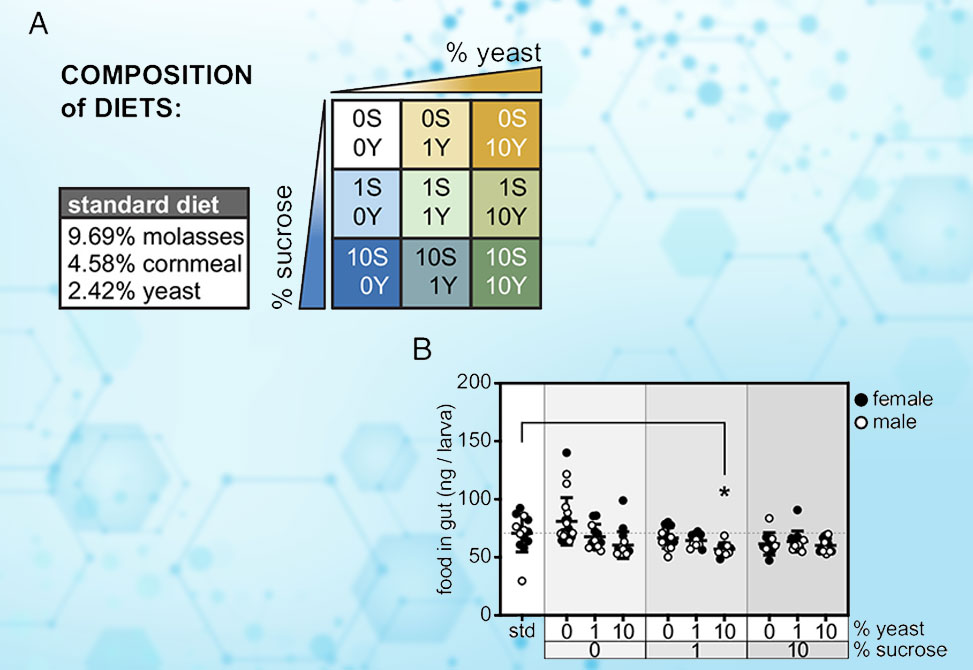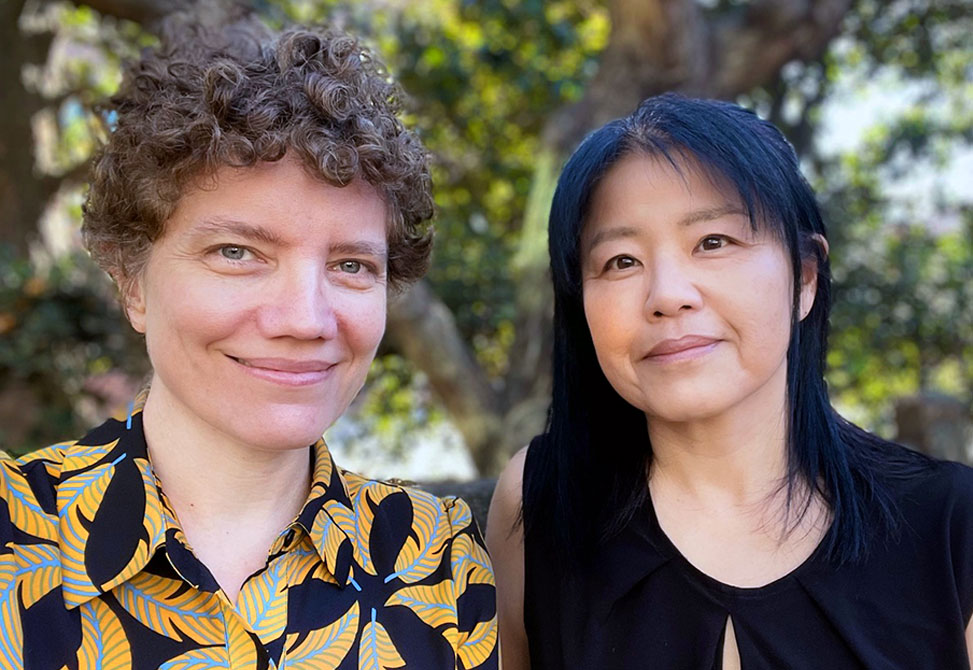Dilp Divergence
Reflecting work in the Bland Group
Insulin-like peptides orchestrate how animals apportion nutrients between storage and growth, yet distinct ligands may encode different cues even when signaling through a single receptor. In this study, researchers in Michelle Bland's Group at the University of Virginia, published in PNAS, dissect how two ligands in Drosophila melanogaster, brain-derived Dilp2 and fat body–derived Dilp6, respond to dietary sugar and protein and, in turn, shape third-instar physiology. Using a rigorous nutritional-geometry paradigm, 0, 1, or 10% sucrose; 0, 1, or 10% yeast extract, while precisely staging larvae with Sgs3-GFP, the authors quantify circulating peptides via tagged alleles and ELISA, and integrate endocrine readouts with trehalose, glycogen, triglyceride stores, and adult wing size as a proxy for peripheral growth.
The endocrine inputs are strikingly divergent. Starvation drastically lowers hemolymph Dilp2 but leaves Dilp6 largely maintained. Sugar-only diets elevate circulating Dilp6 and drive carbohydrate and lipid storage, trehalose↑, glycogen↑, and triglyceride↑, yet fail to trigger Dilp2 release. Conversely, protein robustly restores circulating Dilp2 and rescues growth, but suppresses Dilp6. Both hormones scale with the sugar-to-protein ratio, indicating ratiometric control rather than simple on/off nutrient gating. These patterns are not secondary to ecdysteroid fluctuations at mid-L3, which remain comparable across diets.

Fig. 2. Dilp2 and Dilp6 exhibit divergent responses to dietary sugar and protein.
A| Early- to mid-third instar larvae were fed standard food or experimental diets for 24 h, and hemolymph was collected from those with Sgs3-GFP fluorescence indicating progression to ~108 h AEL. B| Hemolymph Dilp2HF in Dilp21, gDilp2HF, Sgs3-GFP larvae. C| Hemolymph Dilp6HF in Dilp6HF; Sgs3-GFP larvae. n = 4 samples/sex/group, with eight total samples/group. Gray shading in graphs indicates sucrose dose; female and male samples are indicated by filled and open symbols, respectively. Data are presented as means ± SD; *P ≤ 0.0164, **P ≤ 0.0042, ***P = 0.001, ****P < 0.0001 versus standard diet. P values were determined by one-way ANOVA with Dunnett’s multiple comparison test.
Functional genetics anchor causality. Depleting circulating Dilp6 specifically from fat body increases triglyceride stores across multiple diets and diminishes adult wing size, revealing that Dilp6 normally antagonizes fat accumulation while supporting peripheral growth late in larval life. Manipulating the single insulin receptor, InR, in distinct tissues exposes opposing systemic outcomes, overexpressing InR in fat body increases lipid storage but unexpectedly reduces wing growth, whereas fat-body InR knockdown slightly increases wing size. By contrast, cell-autonomous InR up- or down-regulation in the wing pouch respectively enlarges or shrinks wings, as anticipated. Mechanistically, fat-body InR overexpression decreases Dilp6 transcripts, while InR knockdown increases them. Together with Foxo-dependence of Dilp6 expression, this supports a feedback in which elevated local insulin signaling represses Dilp6, likely via Foxo inhibition, thereby throttling a growth-promoting endocrine cue. Sex differences are present but modest, with females showing higher circulating Dilp2 under protein-rich conditions and slightly different Dilp6 dynamics on select diets.
Inter-Dilp crosstalk further refines the system: loss of Dilp2 elevates circulating Dilp6, whereas loss of Dilp6 reduces Dilp2, consistent with reciprocal regulation that differs from adult stages. Phenotypically, Dilp2 deletion yields context-dependent lipid and growth effects, including paradoxical wing-size increases under starvation, plausibly mediated by compensatory Dilp6 upregulation. Together, the data support a model in which Dilp6—induced by sugar and curtailed by protein—biases the late-larval economy to use carbohydrate for growth rather than storage as the developmental window closes, while protein-evoked Dilp2 chiefly drives growth when amino acids are abundant.
This work exposes how a single insulin receptor integrates qualitatively different endocrine messages. The authors propose several, not mutually exclusive, mechanisms: ligand-biased access via binding proteins; tissue-specific receptor isoforms or coreceptors; and ligand-dependent receptor conformations that elicit distinct downstream signaling programs. By establishing nutrient-specific, hormone-specific control points upstream of InR, these findings explain how larvae couple environmental composition to anabolic decisions, and they raise broader questions about differential decoding of related ligands within ostensibly unified insulin pathways.

Nutritional geometry approach. A| Composition of standard laboratory diet and nine experimental diets varying dietary sucrose and yeast extract content. B| Quantity of food in gut in Sgs3-GFP larvae fed standard and experimental diets containing 1% FD&C Blue No.1 for 24 h, from ~84 to 108 h AEL, n = 4 to 11 samples/sex/diet, with 10 to 21 samples total/diet. Gray shading in the graph indicates sucrose dose; female and male samples are indicated by filled and open symbols, respectively. Data are presented as means ± SD; *P = 0.0484 versus standard diet. P values were determined by one-way ANOVA with Dunnett’s multiple comparison test.
Publication Information
Author Information

Michelle Bland, Ph.D., at left, is an Associate Professor in the Department of Pharmacology at the University of Virginia, UVA. Her lab studies the roles of insulin and Toll-like receptor signaling in growth and metabolism, using Drosophila as a genetic model organism. Dr. Bland received her Ph.D. at University of California, San Francisco, UCSF, and did postdoctoral research at University of Pennsylvania.
Miyuki Suzawa, Ph.D., at right, is a Senior Researcher in the Department of Pharmacology at UVA. Her research interests relate to hormonal control of growth and interactions of innate immune and insulin signaling pathways to control gene expression. Dr. Suzawa received her Ph.D. at the University of Tokyo and did postdoctoral research at UCSF.

